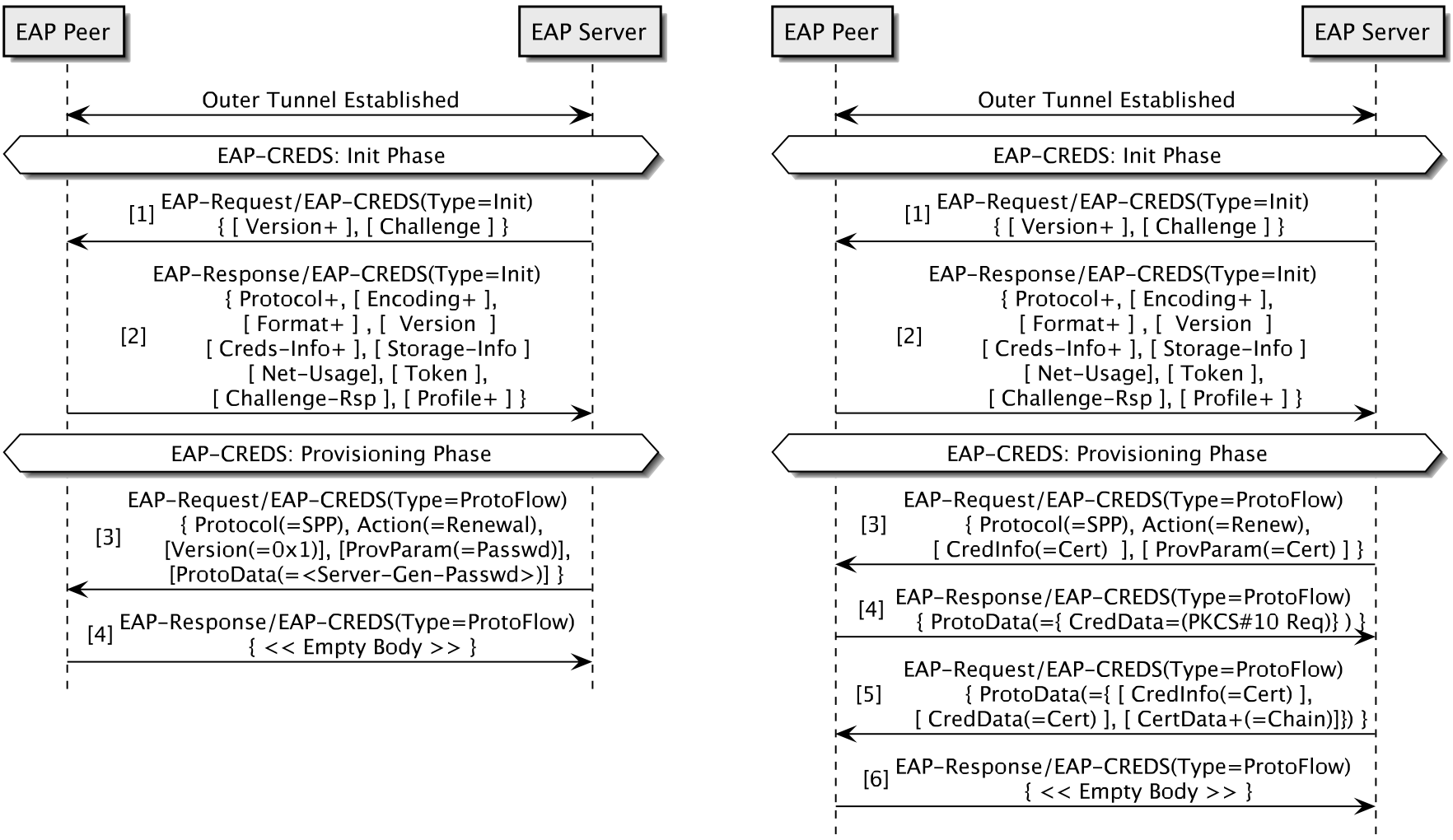Security
EAP-CREDS: Enabling Policy-Oriented Credential Management in Access Networks

In our ever-connected world, we want our devices and gadgets to be always available, independently from where or which access networks we are currently using. There’s a wide variety of Internet of Things (IoT) devices out there, and although they differ in myriad ways – power, data collection capabilities, connectivity – we want them all to work seamlessly with our networks. Unfortunately, it can be quite difficult to enjoy our devices without worrying about getting them securely onto our networks (onboarding), providing network credentials (provisioning) and even managing them.
Ideally, the onboarding process should be secure, efficient and flexible enough to meet the needs of various use cases. Because IoT devices typically lack screens and keyboards, provisioning their credentials can be a cumbersome task: Some devices might be capable of using only a username and a password, whereas others might be able to use more complex credentials such as digital certificates or cryptographic tokens. For consumers, secure onboarding should be easy; for enterprises, the process should be automated and flexible so that large numbers of devices can quickly provisioned with unique credentials.
Ideally, at the end of the process, devices should be provisioned with network-and-device specific credentials, directly managed by the network and unique to the device so that compromises impact that specific device on that specific network. In practice, the creation and installation of new credentials is often a very painful process, especially for devices in the lower segment of the market.
It’s Credentials Management, Not Just Onboarding
After a device is successfully “registered” or “onboarded”, the missing piece that has been and continues to be, so far, ignored is how to manage these credentials. Even when devices allow for configuring them, their deployments tend to be “static” and they rarely get updated. There are two reasons for this: The first reason is the lack of security controls, typically on smaller devices, to set these credentials, and the second, and more relevant, reason is that users rarely remember to update authentication settings. According to a recent article, even in corporate environments, “almost half (47%) of CIOs and IT managers have allowed IoT devices onto their corporate network without changing the default passwords” even though another CISO survey has found that “ ... almost half (47%) of CISOs were worried about a potential breach due to their organization’s failure to secure IoT devices in the workplace.”
At CableLabs we look at the problem from many angles. In particular, we focus on how to provide network credentials management that (a) is flexible, (b) can enforce credentials policies across devices and (c) does not require additional discovery mechanisms.
EAP-CREDS: The Right Tool for the Specific Task
The IEEE Port-Based Network Access Control (802.1x) provides the basis for access network architectures to allow entities (e.g., devices, applications) to authenticate to the network even before being granted connectivity. Specifically, the Extensible Authentication Protocol (EAP) provides a communication channel in which various authentication methods can be used to exchange different types of credentials. Once the communication between the client and the server has been secured via a mechanism such as EAP-TLS or EAP-TEAP, our work (EAP-CREDS), uses the “extensible” attribute of EAP to include access network credentials management.
EAP-CREDS implements three separate phases: initialization, provisioning and validation. In the initialization phase, the EAP server asks the device to list all credentials available on the device (for the current network only) and, if needed, initiates the provisioning phase during which a credentials provisioning or renewal protocol supported by both parties is executed. After that phase is complete, the server may initiate the validation phase (to check that the credentials have been successfully received and installed on the device) or declare success and terminate the EAP session.
To keep the protocol simple, EAP-CREDS comes with specific requirements for its deployment:
- EAP-CREDS cannot be used as a stand-alone method. It’s required that EAP-CREDS is used as an inner method of any tunneling mechanism that provides secrecy (encryption), server-side authentication and, for devices that already have a set of valid credentials, client-side authentication.
- EAP-CREDS doesn’t mandate for (or provide) a specific protocol for provisioning or managing the device credentials because it’s meant only to provide EAP messages for encapsulating existing (standard or vendor-specific) protocols. In its first versions, however, EAP-CREDS also incorporated a Simple Provisioning Protocol (SPP) that supported username/password and X.509 certificate management (server-side driven). The SPP has been extracted from the original EAP-CREDS proposal and will be standardized as a separate protocol.

Figure 2 - Two EAP-CREDS sessions. On the left (Figure 2a), the server provisions a server-generated password (4 msgs). On the right (Figure 2b), the client renews its certificate by generating a PKCS#10 request; the server replies with the newly issued certificate (6 msgs).
When these two requirements are met, EAP-CREDS can manage virtually any type of credentials supported by the device and the server. An example of early adoption of the EAP-CREDS mechanism can be found in the Release 3 of the CBRS Alliance specifications where EAP-CREDS is used to manage non-USIM based credentials (e.g., username/password or X.509 certificates) for authenticating end-user devices (e.g., cell phones). Specifically, CBRS-A uses EAP-CREDS to transport the provisioning messages from the SPP to manage username/password combinations as well as X.509 certificates. The combination of EAP-CREDS and SPP provides an efficient way to manage network credentials.
SPP and EAP-CREDS: Flexibility and Efficiency
To understand the specific type of messages implemented in EAP-CREDS and SPP, let’s look at Figure 2a which shows a typical exchange between an already registered IoT device and a business network.
In this case, after successfully authenticating both sides of the communication, the server initiates EAP-CREDS and uses SPP to deliver a new password. The total number of messages exchanged in this case is between four (when server-side generation is used) and six (when co-generation between client and server is used). Figure 2b provides the same use-case for X.509 certificates where co-generation is used.
One of the interesting characteristics of EAP-CREDS and SPP is their flexibility and ability to easily accommodate solutions that, today, need to go through more complex processes (e.g., OSU registration). For instance, SPP can also be used to register existing credentials in two ways. Besides using an authorization token during the initialization phase (i.e., any kind of unique identifier, whether a signed token or a device certificate), devices can also register their existing credentials (e.g., their device certificate) for network authentication.
Policy-Based Credentials Management
As we’ve seen, EAP-CREDS delivers an automatic, policy-driven, cross-device credentials-management system and its use can improve the security of different types of access networks: industrial, business and home.
For the business and industrial environments, EAP-CREDS provides a cross-vendor standard way to automate credentials management for large number of devices,(not just IoT) thus making sure that (a) no default credentials are used, (b) that the ones (credentials) that are used are regularly updated and (c) credentials aren’t shared with other (possibly less secure) home environments. For the home environment, EAP-CREDS provides the possibility to make sure that the small IoT devices we’re buying today aren’t easily compromised because of weak and static credentials and provides a complementary tool (for 802.1x-enabled networks only) to consumer-oriented solutions like the Wi-Fi Alliance’s DPP.
If you’re interested in further details about EAP-CREDS and credentials management, please feel free to contact us and start something new today!


